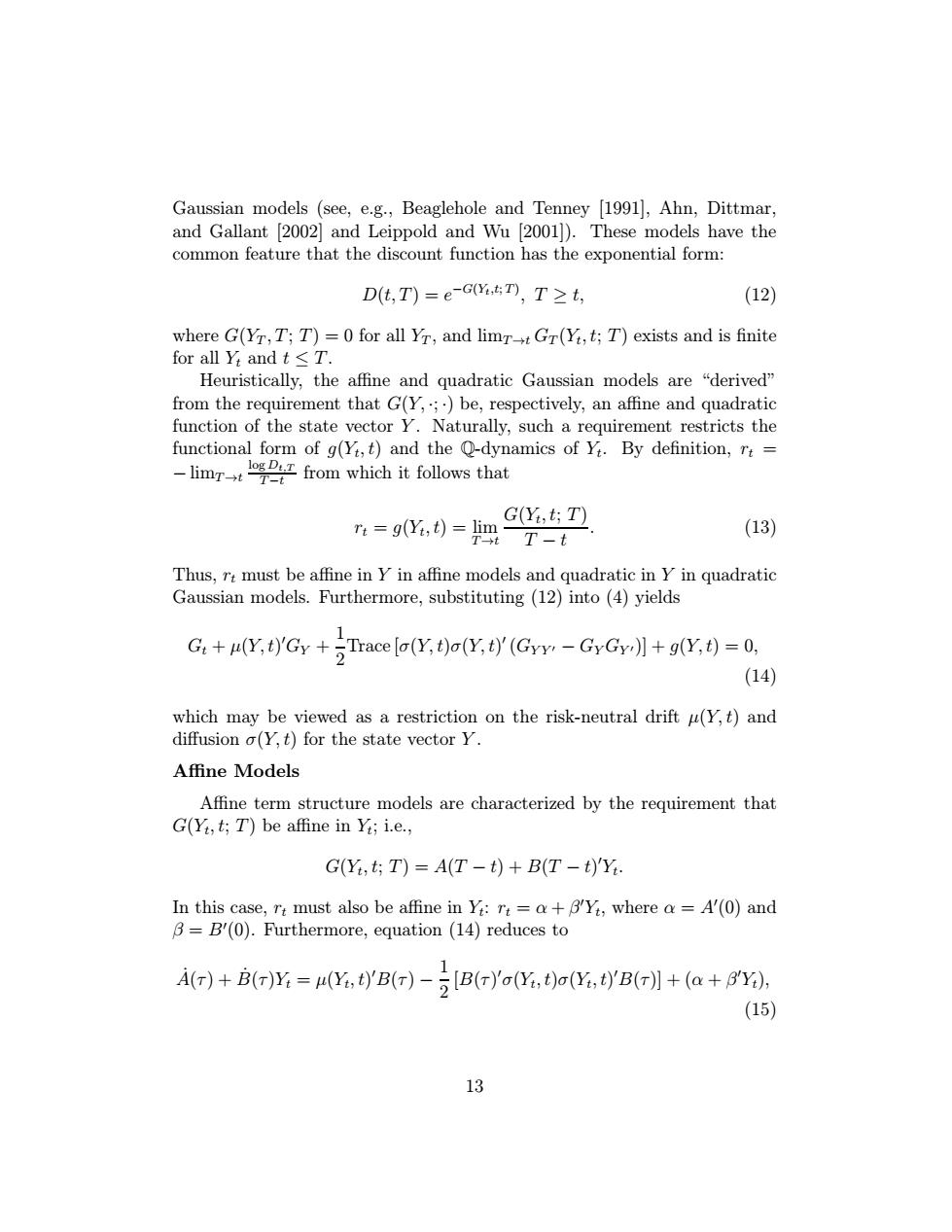正在加载图片...

Gaussian models (see,e.g.,Beaglehole and Tenney [1991],Ahn,Dittmar, and Gallant [2002]and Leippold and Wu [2001]).These models have the common feature that the discount function has the exponential form: D(t,T)=eGm4TD,T≥t, (12) where G(Yr,T;T)=0 for all Yr,and limrt Gr(Yi,t;T)exists and is finite for all Y:and t≤T. Heuristically,the affine and quadratic Gaussian models are "derived" from the requirement that G(Y,;)be,respectively,an affine and quadratic function of the state vector Y.Naturally,such a requirement restricts the functional form of g(Yi,t)and the Q-dynamics of Yi.By definition,rt= limfrom which it follows that r=g(Yi,t)=lim G(Yi,t;T) T→tT-t (13) Thus,rt must be affine in Y in affine models and quadratic in Y in quadratic Gaussian models.Furthermore,substituting (12)into (4)yields G+(Y,t)'Gr+Trace [o(Y,t)a(Y,ty(Gyy-GyGy+(Y,t)=0, (14) which may be viewed as a restriction on the risk-neutral drift u(Y,t)and diffusion o(Y,t)for the state vector Y. Affine Models Affine term structure models are characterized by the requirement that G(Yi,t;T)be affine in Y;i.e., G(Yi,t;T)=A(T-t)+B(T-t)'Yi. In this case,r:must also be affine in Yi:r:=a+B'Yi,where a=A'(0)and B=B(0).Furthermore,equation (14)reduces to A()+B(r)Y:=u(Y,t)'B(r)-5[B(r)'o(Vi,t)a(Yi,t)'B(r)+(a+B'Y:), (15) 13Gaussian models (see, e.g., Beaglehole and Tenney [1991], Ahn, Dittmar, and Gallant [2002] and Leippold and Wu [2001]). These models have the common feature that the discount function has the exponential form: D(t, T) = e−G(Yt,t; T) , T ≥ t, (12) where G(YT , T; T) = 0 for all YT , and limT→t GT (Yt, t; T) exists and is finite for all Yt and t ≤ T. Heuristically, the affine and quadratic Gaussian models are “derived” from the requirement that G(Y, ·; ·) be, respectively, an affine and quadratic function of the state vector Y . Naturally, such a requirement restricts the functional form of g(Yt, t) and the Q-dynamics of Yt. By definition, rt = − limT→t log Dt,T T −t from which it follows that rt = g(Yt, t) = limT→t G(Yt, t; T) T − t . (13) Thus, rt must be affine in Y in affine models and quadratic in Y in quadratic Gaussian models. Furthermore, substituting (12) into (4) yields Gt + µ(Y, t) 0 GY + 1 2 Trace [σ(Y, t)σ(Y, t) 0 (GY Y 0 − GY GY 0)] + g(Y, t)=0, (14) which may be viewed as a restriction on the risk-neutral drift µ(Y, t) and diffusion σ(Y, t) for the state vector Y . Affine Models Affine term structure models are characterized by the requirement that G(Yt, t; T) be affine in Yt; i.e., G(Yt, t; T) = A(T − t) + B(T − t) 0 Yt. In this case, rt must also be affine in Yt: rt = α + β0 Yt, where α = A0 (0) and β = B0 (0). Furthermore, equation (14) reduces to A˙(τ ) + B˙(τ )Yt = µ(Yt, t) 0 B(τ ) − 1 2 [B(τ ) 0 σ(Yt, t)σ(Yt, t) 0 B(τ )] + (α + β0 Yt), (15) 13